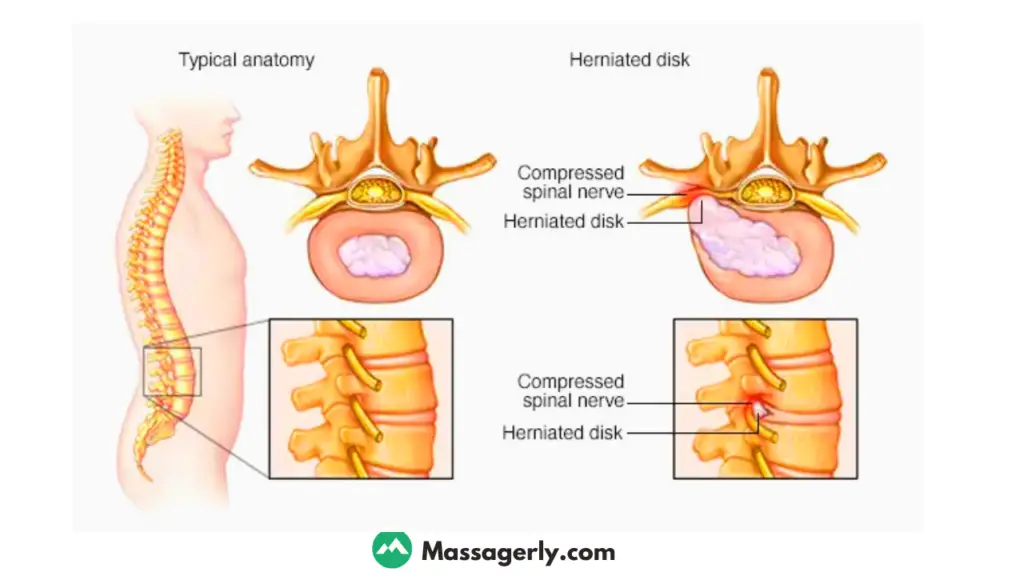Can massage make herniated disc worse? Imagine this: you’re seeking relief from the discomfort of a herniated disc, hoping for the magic touch that will alleviate your pain. But there’s a lingering doubt – could this well-intentioned massage actually do more harm than good?
Don’t worry; you’re not alone in this concern. Herniated discs, also known as bulging discs, affect a substantial portion of the population, with around 5% of adults between the ages of 30 and 50 experiencing them1. As you embark on this journey to find solace, let’s demystify the world of massages and herniated discs, exploring whether a seemingly innocent knead could potentially exacerbate your discomfort. So, is it a risk worth taking? Let’s delve into the depths of this question and discover the real scoop on whether massage can make herniated disc worse.
In the realm of alternative therapies, massage has gained popularity as a potential remedy for various musculoskeletal conditions, including herniated discs. However, when it comes to herniated discs, a common concern arises: can massage make the condition worse? In this article, we will delve into the intricacies of using massage as a potential treatment for herniated discs, discussing its benefits, risks, and the best practices to follow.
Understanding Herniated Discs
Before we explore the impact of massage, let’s grasp the basics of herniated discs. A herniated disc, often referred to as a bulging disc or slipped disc, occurs when the soft inner core of an intervertebral disc pushes through a weakened or damaged outer layer. This condition can cause localized pain, numbness, tingling, and even radiating pain down the arms or legs, depending on the location of the herniation.

Can Massage Make Herniated Discs Worse?
Benefits of Massage for Herniated Discs
Massage therapy is renowned for its potential to alleviate muscle tension, improve blood circulation, and reduce stress. When applied skillfully, massage can have several positive effects on individuals with herniated discs:
- Muscle Relaxation: Massage can target tense muscles around the affected area, providing relief by reducing muscle spasms and promoting relaxation.
- Blood Flow Enhancement: Improved blood circulation can aid in delivering nutrients and oxygen to the affected area, potentially supporting the healing process.
- Pain Management: Certain massage techniques, when performed by trained professionals, can help manage pain perception by stimulating the release of endorphins, the body’s natural painkillers.
Risks of Massage for Herniated Discs
However, caution is warranted. Improper massage techniques, especially those involving excessive pressure, can lead to detrimental effects:
- Increased Irritation: Aggressive massage on the area of the herniation might exacerbate the condition, leading to heightened irritation of the nerves.
- Nerve Compression: Inappropriate manipulation can potentially compress the nerves further, intensifying pain and discomfort.
Best Practices: How to Approach Massage for Herniated Discs
If you’re considering massage as part of your herniated disc management, it’s crucial to follow these guidelines:
Consult a Professional
Before undergoing any massage therapy, consult a medical professional or a qualified massage therapist. They can evaluate your specific condition and recommend appropriate techniques.
Communicate Clearly
When meeting with a massage therapist, communicate your condition and concerns clearly. Ensure they have a thorough understanding of your herniated disc and any related symptoms.
Choose the Right Techniques
Opt for gentle and non-invasive massage techniques, such as Swedish massage or myofascial release. Avoid deep tissue massage or intense pressure directly on the herniation site.
Localized Approach
Focus the massage on the surrounding muscles rather than directly on the herniated disc itself. Targeting the supporting muscles can help alleviate tension without risking direct irritation to the herniation.
Mindful Progression
Start with shorter sessions and assess how your body responds. Gradually increase the duration and intensity of the massage if you experience positive outcomes.
Conclusion
In conclusion, the question of whether massage can help or harm a herniated disc is nuanced. When approached with care and under the guidance of a knowledgeable professional, massage therapy has the potential to offer relief for individuals with herniated discs. The key lies in choosing the right techniques, communicating effectively, and prioritizing your safety.
Remember, there is no one-size-fits-all answer, and what works for one individual might not work for another. Consulting with a healthcare provider and seeking advice from experienced massage therapists are essential steps to ensure that massage becomes a valuable tool in your journey to managing herniated disc discomfort.
- 8 Key Differences: Swedish vs Deep Tissue Massage Unveiled
- 4 Effective Ways: How Can Massage Help a Pinched Nerve ?
FAQs
Is Massage Bad for Herniated Disc?
Massage is not inherently bad for a herniated disc, but it needs to be approached cautiously. Improper techniques, excessive pressure, or manipulation directly on the herniation site can potentially worsen the condition. However, when performed by a trained professional with knowledge of herniated discs, massage can offer relief by targeting surrounding muscles and promoting relaxation.
Can You Massage Around a Bulging Disc?
Yes, you can receive a massage around a bulging or herniated disc, but it’s essential to choose the right techniques and communicate your condition with the massage therapist. Gentle and non-invasive techniques that focus on the surrounding muscles are preferable. Always consult with a medical professional or a qualified massage therapist before proceeding.
How Do You Massage Your Back with a Herniated Disc?
When massaging your back with a herniated disc, it’s crucial to prioritize safety and follow these steps:
- Consult a Professional: Seek advice from a medical professional or experienced massage therapist to ensure that massage is appropriate for your specific condition.
- Choose Gentle Techniques: Opt for techniques like Swedish massage or myofascial release that don’t involve intense pressure on the herniation site.
- Focus on Surrounding Muscles: Target the muscles around the herniation site to alleviate tension and promote relaxation without directly irritating the herniation.
- Communication: Clearly communicate your condition and any discomfort you’re experiencing with the massage therapist.
- Mindful Progression: Start with shorter sessions and gradually increase the duration and intensity based on your body’s response.
Can Pressing on Herniated Disc Make It Worse?
Yes, pressing directly on a herniated disc can potentially make it worse. Excessive pressure or manipulation on the herniation site might lead to increased irritation of the nerves, compression, and heightened pain. It’s advisable to avoid intense pressure on the herniated area and focus on surrounding muscles instead.
Remember, every individual’s condition is unique, so consulting medical professionals and experienced massage therapists is crucial before attempting any massage therapy for herniated discs.

